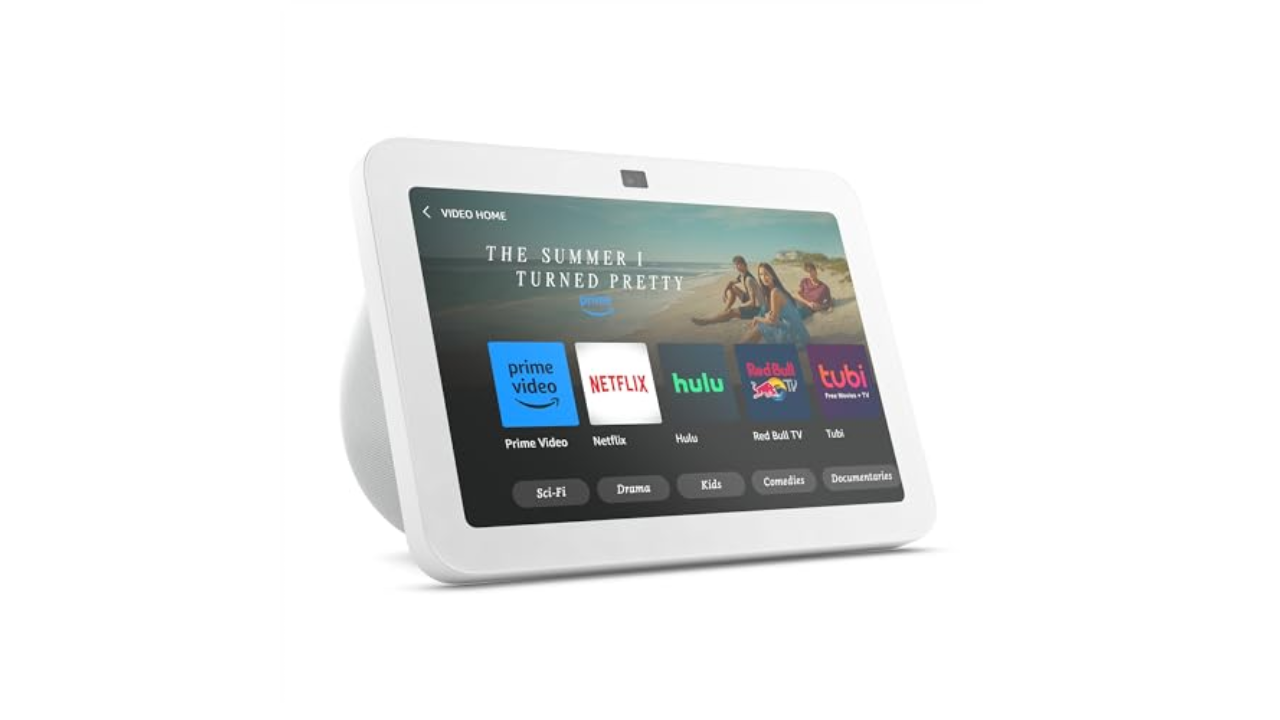Hot take: A smart speaker is the single best tech tool to help seniors stay safe, entertained and productive. Think about it: With a simple voice command, you can get a weather report, adjust the thermostat, turn lights on, start Netflix, make calls to family members or just fill the house with music on a quiet morning.
Granted, some of these capabilities require additional hardware, but even on its own, a smart speaker can do a ton. So what’s the best smart home speaker for seniors? To find out, we analyzed various models based on cost, ease of setup, built-in features and compatibility with other gadgets. In the end, five emerged as top picks.
They’re listed below, but be sure to scroll past the reviews to learn more about these devices — what they can do, how we made our choices, any privacy concerns you should know about and so on. And if you’re looking for other smart gadgets designed specifically for older users, check out our lists of the best cell phones for older adults and the best tablets for seniors.
The best overall smart speaker for seniors
Assistant: Alexa | Connectivity: Bluetooth, Wi-Fi | Spatial audio: Yes | Special features: 8-inch touchscreen
Imagine a tablet with a beefy speaker grafted onto the back: That’s the Echo Show 8 in a nutshell. Although it responds to all the same Alexa voice commands as an Echo Dot or Echo Studio, it adds a touchscreen to the mix. Not only can you engage in video calls (to other Echo users or via Zoom), you can watch Netflix, Hulu and lots of other streaming video (though a few streamers, like Max and YouTube, aren’t available).
I’m a big fan of the Show 8 as a kitchen appliance, as it can show cooking demonstrations while you follow along or just keep you company with music or podcasts while you whip up a meal.
You can also see — not just hear — things like weather reports, calendar entries, medication reminders and more. If you have any compatible external cameras in the mix — like, say, a video doorbell — the Echo Show 8 can show you a real-time video feed. And when you’re not actively interacting with the device, it can default to a photo slideshow, just like a dedicated digital picture frame. (Unfortunately, Amazon doesn’t make it easy to add new photos, or let friends and family do likewise.)
This 2023 model improves on the already-great 2021 version in a few ways: It has a faster processor and support for more smart-home devices (namely those compatible with Matter, Thread and Zigbee). Amazon has also made improvements to the speaker, adding spatial audio for a more room-filling sound. A newly centered camera lens makes video calling better as well.
Suffice it to say, this is arguably the most versatile smart speaker you can get — because it’s way more than just a speaker. What’s especially amazing is the price: $150 feels like a steal for a device this capable, and Amazon has occasionally discounted it as low as $90.
- High-quality screen and speaker
- Works with nearly all popular smart-home platforms
- Includes camera privacy shutter
- Tons of senior-friendly accessibility features
- Missing a few streaming apps
- Complicated to set up and use as a digital picture frame
The best budget smart speaker for seniors
Assistant: Alexa | Connectivity: Bluetooth, Wi-Fi | Spatial audio: No | Smart Home Hub compatibility: Matter | Special features: Motion and temperature sensors, Wi-Fi extender
There’s an embarrassment of smart-speaker riches packed into the current-generation Echo Dot, which has a list price of $50 but routinely goes on sale for $30 to 40. In addition to all the usual Alexa-powered capabilities, it has temperature and motion sensors that can link with other smart devices in your home. Example: You walk into your bedroom and it triggers a lamp — plugged into a smart AC outlet — to turn on.
No less impressive, it can double as a Wi-Fi range extender as part of an Eero mesh network. Continuing with the bedroom example, if Wi-Fi signal strength in there isn’t great, the Dot can boost it.
All this comes from a little orb that sounds surprisingly decent for its size. It may not be the speaker you want for jamming to your favorite albums, but for things like news, podcasts, nighttime meditations and the like, it’s more than adept.
If you’re planning to put this on your nightstand, consider the Echo Dot with Clock, which adds a dimmable LED display. It shows not only the time, but also weather, song titles and more. It’s just $10 more.
- Low price, and often discounted
- Good sound quality for its size
- Can double as a Wi-Fi range extender (for Eero networks)
- Rather unattractive design
- Physical controls are hard to see
The rest of the best smart speakers for seniors
Assistant: Google | Connectivity: Bluetooth, Wi-Fi | Spatial audio: No | Smart Home Hub compatibility: Matter, Thread | Special features: Touch controls
A solid competitor to Amazon’s $99 Echo, the Nest Audio delivers nice sound from an attractive monolithic package (one that’s available in three soothing colors). And if you want a better music experience, true stereo awaits by pairing a second speaker. Just be prepared for some possible confusion during setup.
I like the inclusion of a printed privacy guide that explains how the Nest Audio uses its microphones as well as how to disable them using a physical switch on the back of the device. There’s also a printed setup guide, though the Google Home app that walks you through the configuration is a little awkward in places. There’s a whole thing about “personal results” that I found fairly incomprehensible. And after setting up the Nest Audio, the app asked if I wanted to set up “Watch movies & shows” — confusing because the Nest Audio has no screen.
Another oddity: The speaker’s touch controls are unmarked and effectively invisible. To adjust volume, for example, you tap the top front left or front right corner; to play or pause, you tap the top front center. Granted, these controls aren’t difficult to remember, and you can use your voice instead, but it seems almost user-hostile that Google didn’t at least silk-screen some button labels onto the device.
At press time, Google was soon to roll out an updated version of the Home app, which is good because it’s definitely the weak link in the chain. But app and button gripes aside, the Nest Audio works very well overall and delivers a robust smart-speaker experience. If you want a more affordable option, the Google Mini costs just $49. It’s smaller and lacks audio oomph, but functionally it’s just as good.
- Nice design and color options
- Can pair with a second Nest for true stereo sound
- Confusing setup
- Difficult touch controls
Assistant: Alexa | Connectivity: Bluetooth, Wi-Fi | Spatial audio: Yes | Smart Home Hub compatibility: Matter, Zigbee | Special features: Dolby Atmos
Available in black or white, the Echo Studio can fill a room like few other standalone speakers. That’s primarily due to its spatial-audio and Dolby Atmos capabilities, which work some technological magic to produce a sound stage that’s big, full and deep. For anyone who loves music and wants to enjoy it to the fullest, the Studio is the next best thing to a good set of headphones. It gets even better if you pair a second Studio and then add the Amazon Echo Sub, a robust subwoofer. Now you’ve got a setup that would rival, if not outright beat, any traditional stereo system.
Although the Studio doesn’t share the Eero Wi-Fi network or motion/temperature features of its smaller Echo and Echo Dot siblings, it does have a built-in Zigbee home hub if you want to extend your smart-home options beyond what you can already do with Alexa. It supports newer Matter and Thread standards as well.
What’s more, if you own a TV that runs Amazon’s Fire TV operating system, the Studio can pair with it for soundbar duties. Granted, it might not have the same oomph as a full-fledged ‘bar, but it’ll certainly sound better than your TV’s built-in speakers. (For the record, Apple’s HomePod can do this as well, but only if you have an Apple TV 4K plug-in streamer.)
This is definitely one of Amazon’s most expensive Echo devices, but it’s worth it you prize audio fidelity — and if you wait for a sale, you might be able to grab one for around $160.
- Top-notch sound enhanced by spatial audio and Dolby Atmos
- Can pair with a second Studio for true stereo sound
- Can pair with an Amazon Fire TV for use as a soundbar
- On the pricier side
- Lacks the Eero Wi-Fi extender capabilities of cheaper Echo speakers
Assistant: Siri | Connectivity: AirPlay, Bluetooth, Wi-Fi | Spatial audio: Yes | Smart Home Hub compatibility: Matter, Thread | Special features: Temperature, humidity sensors
The HomePod is an odd duck, lacking the glitzy style of so many other Apple products, but it’s a fairly competent smart-home speaker nonetheless. As you’ve probably guessed, it’s a Siri-powered device, the only one in this roundup, and that means it’s best suited to users of other Apple products (iPhone, iPad and so on) and Apple HomeKit-compatible smart devices.
Assuming you do own an iPhone or iPad, the HomePod is a snap to set up. All you do is plug it in, then point your phone or tablet camera at the glowing multicolor panel on top. A few taps later, the HomePod becomes part of your home network. Presto: You’re done.
With this second-generation model adding support for spatial audio, the HomePod rivals Amazon’s larger Echo Studio in terms of sound quality. It also supports Matter, a fairly new smart-home standard promising to better connect devices across different platforms. So there’s some future-proofing baked in here as well. Onboard temperature and humidity sensors are nice touches (“Hey, Siri, what’s the temperature in here?”), as are the alarm detectors: If the HomePod hears a smoke or carbon-monoxide alarm, it can send a notification to your iPhone and Apple Watch.
Like most Apple products, the HomePod is on the pricey side: At $299, it’s $99 more than the Echo Studio. But, again, if the Apple ecosystem rules in your house, it’s almost certainly the best option. And for anyone who doesn’t prioritize room-filling music, the $99 HomePod Mini has all the same core capabilities for a much more affordable price.
- Easy to set up
- Superb sound quality, plus spatial audio
- Built-in temperature and humidity sensors
- Unattractive design
- Expensive
- Limited compatibility with other smart devices
What is a smart home speaker?
Traditional speakers (think: home stereo, clock radio, etc.) produce sound in the form of music, NPR and so on. A smart speaker, which is most often a standalone device, adds one or more microphones to the mix, allowing it to hear your spoken questions and commands. It will then respond to your input and, when applicable, take action. Neat, right?
All this is made possible by adding the speaker to your home Wi-Fi network; it’s only “smart” when it’s connected to the internet. So be prepared for setup, which typically requires your phone, an app and possibly your Wi-Fi network password.
What can a smart home speaker do?
If you’ve never used one before, you may be surprised: These devices are amazingly capable. Here’s just a smattering of senior-friendly tools they offer, all just a voice command away:
-
Play music and live-streaming radio
-
Create a shopping list
-
Remind you to take medicine or keep an appointment
-
Adjust lighting (on/off, dim)
-
Turn the TV on/off
-
Make emergency calls
-
Provide news briefings
-
Read weather reports
-
Set kitchen timers
-
Play podcasts and audiobooks
-
Make voice (or video) calls to friends and family members
If you’re in the kitchen, you can ask for measurements (“How many cups in a pint?”) and recipe help (“How do I know if my baking soda is still good?”). If you have other smart-home devices like smart plugs or a smart TV, you can tell the speaker to turn off a light or play Grace and Frankie on Netflix. I won’t say the possibilities are endless, but they’re pretty vast.
In some cases, you can also purchase a remote caregiving service that integrates with the speaker, an added measure of security for those who live alone or have health concerns.
Are smart speakers a privacy concern?
This question comes up a lot due to the nature of smart home speaker technology: By design, their microphones are always on, always listening. Not everyone is comfortable with that, which is understandable. However, keep in mind that smart speakers don’t actually do anything unless you’ve first invoked the wake word: “Alexa,” “Hey, Google” or “Siri.”
OK, but what happens then? Are your commands recorded and saved? Processed by humans? Used to uncover your darkest secrets? Is the government coming?! These are (mostly) legitimate concerns, but allow me to put your mind at ease: While Amazon, Apple and Google have slightly different policies when it comes to smart-speaker data collection and usage, they’re just businesses. They want to improve how their products perform and, sure, sell you more stuff. But marketing isn’t inherently nefarious, and in most cases, you have the option of deleting any recordings stored by your speaker.
Using one is, of course, a personal decision, but I think the benefits vastly outweigh any privacy risks. I’ve owned smart speakers for nearly a decade; so far, the government has broken down my door exactly zero times. (Your mileage may vary.)
How we picked the best smart home speakers
A lot of these products have been around a long time, with the occasional update every couple years. Their core capabilities haven’t really changed: You ask a question or issue a command, and the speaker responds. Most of the tweaks have been physical — different shapes and colors — and under the hood, with improvements to speaker quality and microphone sensitivity. Of course, the virtual assistants — Alexa, Google, Siri — have grown better with time as well.
The result is that most modern smart speakers are varying degrees of very good, which begs the question: What makes one better than another? Sound quality is a factor, of course, and that might be important for anyone who enjoys listening to music. You can definitely tell the difference between, say, the Apple HomePod and the Amazon Echo Dot. (The former sounds great; the latter, good.)
You can find countless reviews that focus on audio fidelity; we’re here to look at how well these devices are suited to older users. Thus, in making our picks, we looked not just at price, design and sound quality, but also:
-
Ease of setup
-
Ease of calling family members and/or emergency services
-
Integration with other smart-home devices
-
Integration with safety devices
-
Senior-specific capabilities
Spoiler alert: There’s a clear standout here, and that’s Amazon’s Echo lineup. It offers not only the broadest array of products, but the most senior-friendly virtual assistant in the form of Alexa. And although Echoes aren’t linked to a phone-based ecosystem like Apple’s HomePod (iPhone, natch) and Google’s Nest (Android), they can still make calls. If you opt for an Echo that has a screen, you get video calling as well.
Speaking of screens, the Amazon Echo Shows and Google Nest Hubs have them, so they’re a little more tablet-like in their capabilities. In addition to video calls, they can play content from the likes of YouTube and Netflix, show weather reports, stream feeds from security cameras and run a slideshow of your favorite photos. For the moment, Apple doesn’t offer a screen-equipped smart speaker.
Let’s take a closer look at each assistant and what it has to offer to older users.
Alexa for seniors
Alexa isn’t always the smartest assistant in the room (Google earns that crown), but on the whole, she’s quite effective — and has an amazing supporting cast. Amazon’s gal leads the pack in terms of “skills,” many of which are integrations with third-party tools and services. For example, you can enable skills that’ll make your misplaced phone ring, play white noise at bedtime or challenge you to a geography quiz.
Even better, there are lots of skills specifically designed for seniors. If you take daily blood pressure readings, a skill called Alex Care can record them for you (through voice prompts) — and alert you if they’re not normal. If you live in a senior community that works with support service Caremerge, you can ask for things like daily announcements or whether the mail has been delivered.
Alexa-powered Echo devices can also make phone calls, either to numbers in your contact list (which can be imported into the Alexa app) or any number you ask Alexa to dial. One exception: 911. But see below regarding the Alexa Together option, which adds support for emergency services.
Amazon’s Alexa Together is a remote-caregiving service designed to help family members keep tabs on loved ones, particularly those living on their own. For example, it can alert you of the first Alexa interaction of the day and deliver custom reminders (think: medication) at specific times. But the real win here is 24/7 Urgent Response, which affords hands-free access to emergency services. (In the event of, say, a fall or chest pains, just say, “Alexa, I need help.”) Activating that part of the service also sends immediate notifications to participating family members.
Alexa Together can also integrate with various fall-detection devices, such as the SkyAngelCare Pendant. In the event of a fall, Alexa will ask the wearer if he or she is okay, then engage Urgent Response if needed.
The service costs $20 monthly; there’s currently a 30-day free trial available. Worth noting: Amazon also offers an array of Alexa-based accessibility features for those who struggle with hearing, vision, mobility and so on.
All this adds up to what we consider the best virtual assistant for seniors, especially considering the wide array of products — some starting at just $40.
Google Assistant for seniors
If you own an Android phone, you’re probably well-acquainted with Google Assistant, who also lives inside Google’s Nest Audio and Mini smart speakers. That kind of continuity can be nice; the same is true for Siri-using iPhone owners (see below). However, Google Assistant doesn’t offer the same breadth of skills as Alexa, though it does work with a similarly wide assortment of smart-home devices. What’s more, I think Google’s gal does a better job with general-information inquiries — because, well, Google.
It’s too bad, then, that the search giant doesn’t cater to seniors in any meaningful way. Although you can set reminders and the like, there’s no integration with caregiver services or fall-detection devices.
As for voice calling, the Nest Audio and Mini support it either with or without your smartphone getting involved, but there’s some complexity behind it. For example, if you activate what’s called “Google-supported calling,” you can make audio calls — but only to people in your Google Contacts list. You can’t dial, say, a pharmacy unless you first add that number to the list. You also can’t make emergency calls. Another option is carrier calling, which brings your phone into the mix and lets you call any number. However, this works only if Google Fi is your carrier, and emergency services still aren’t supported.
Siri for seniors
If you own an iPhone, you’re probably well-acquainted with Siri, who also lives inside the Apple HomePod. Like other assistants, she can respond to a wide range of questions and requests, as well as turn voice commands into actions — turning off lights, adjusting the thermostat and so on. However, there’s a catch: These commands work only with smart-home products that support Apple’s HomeKit technology, and there’s a comparatively small number that do. For example, this popular Kasa Smart Plug 2-pack works with Alexa and Google Assistant, but not HomeKit. That’s also true of the Wyze Cam v3 Indoor/Outdoor Camera and many other well-known devices.
Thus, if you’re hoping to make the HomePod into a hub for your smart home, you may be disappointed. It can be done, but you won’t have the same massive selection of compatible products.
Assuming you live within that ecosystem, however, you’re likely to find Siri a valuable companion. With your iPhone in close proximity, you can make hands-free phone calls and send text messages the same way. If you have multiple HomePod devices (including the HomePod Mini) around the home, they can function as intercoms.
But Siri herself doesn’t offer any real senior-specific advantages, like integration with a home-care service or a family check-in option. So, again, while she’s a solid choice for iPhone users, she’s not necessarily the best choice overall.

Olivia Martin celebrates the art of living well in her lifestyle articles. She explores topics ranging from travel and fashion to home decor and culinary delights, offering inspiration for readers seeking a balanced and enjoyable lifestyle.







